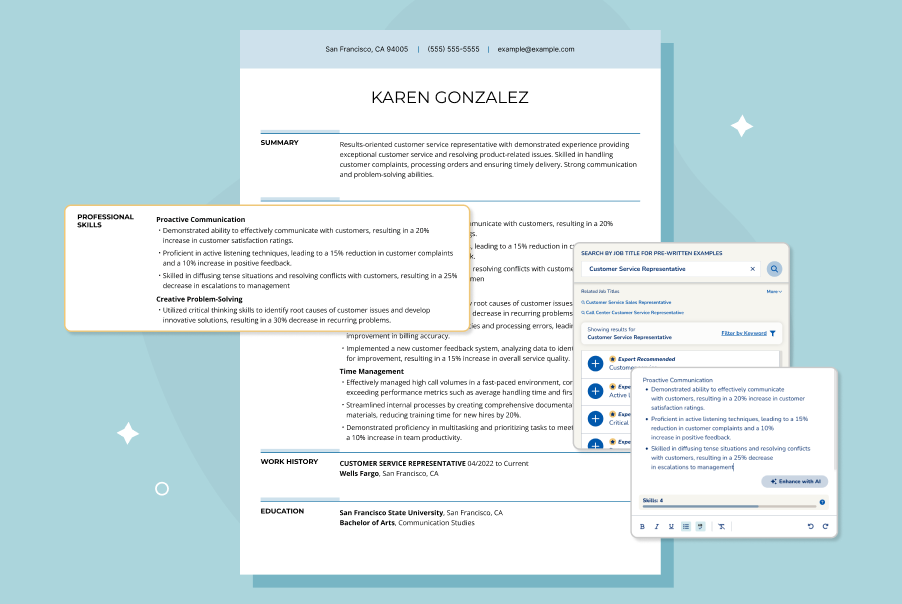Our customers have been hired at: *Foot Note
In recent years, return-to-office (RTO) policies have become a focal point for organizations navigating the post-pandemic workplace.
As businesses redefine their operational models, employees are balancing the demands of in-office work with the flexibility of remote or hybrid arrangements.
In this article, we’ll explore return-to-office trends and offer strategies for navigating the shifting landscape of workplace expectations. Jump to the following key topics to get started:
What Is an RTO Policy?
An RTO policy refers to a return-to-office policy, which outlines the expectations, guidelines and procedures for employees returning to the office after a period of partial or fully remote work.
RTO policies have gained prominence in recent years as employers reevaluate in-office work expectations following the widespread adoption of remote work during the COVID-19 pandemic.
Policies may outline hybrid models, fixed in-office schedules or full-time returns, including the reasoning for the return, logistical considerations and accommodations for employee needs.
Why Are Companies Requiring Return-to-Office?
Some companies are pushing for employees to return back to the office for various reasons, often tied to strategic goals, operational needs and perceptions of workplace dynamics.
Here’s a closer look at some of the primary motivations driving RTO mandates:
- Collaboration and innovation: Many employers believe in-person interactions are more conducive to brainstorming, problem-solving and innovation.
- Reinforcing company culture: Physical presence can help some employees feel more connected to the organization, its mission and company values.
- Supervision and accountability: Some employers feel that remote work may reduce oversight, leading to challenges in ensuring accountability.
- Leveraging office investments: Companies with significant investments in office spaces and amenities aim to utilize these assets with in-office requirements.
- Strengthening team dynamics: Teams can often foster stronger interpersonal skills and bonds through face-to-face collaboration, improving trust and communication.
- Alleviating remote work challenges: For some, prolonged remote work can lead to feelings of isolation, worker burnout and reduced engagement.
MyPerfectResume career advice professional Toni Frana explained the following:
Companies want to ensure employees are working together to solve critical problems as they arise. In addition, company leaders see value in face-to-face time among teams. As a result, there has been a strong push from many organizations to require employees to return to the office.- Toni Frana, Career Professional
Top Companies Requiring Return-to-Office
Several major companies have implemented return-to-office mandates, requiring employees to increase their in-office presence. Below are a few notable examples.
Amazon
The tech giant has mandated that corporate employees return to the office five days a week as of Jan. 2, 2025.
CEO Andy Jassy emphasized the benefits of in-person collaboration and the company's commitment to an office-centric culture.
JPMorgan Chase
The largest U.S. bank has announced that starting in March, employees currently on hybrid schedules will be required to return to the office five days a week.
This policy shift aligns with CEO Jamie Dimon's longstanding advocacy for in-person work to enhance productivity and collaboration.
Google has enforced a hybrid work policy requiring employees to be in the office at least three days a week. The company believes that this hybrid model supports productivity and innovation.
Disney
Disney has required employees to return to the office four days a week, emphasizing the importance of in-person collaboration and creativity in their work environment.
Apple
Apple has implemented hybrid work policies requiring employees to work in the office at least three days a week, typically Tuesdays, Thursdays and a third day selected by team leaders.
This hybrid approach aims to balance the benefits of in-person collaboration with the flexibility of remote work.
AT&T
The telecommunications company has required all office employees to work on-site five days a week starting in January 2025.
This move follows a period during which AT&T accommodated hybrid schedules, reflecting a shift toward prioritizing in-person collaboration and business outcomes.
If you are applying for a new role, we recommend using our Resume Builder for professional templates and industry-tailored content suggestions.
Employee Response to Return-to-Office Mandates
While companies may have strong reasons for enforcing RTO policies, many are facing return-to-office backlash from employees who value the flexibility of remote or hybrid work.
A recent survey on RTO policies conducted by MyPerfectResume in February 2024 with over 4,200 U.S. respondents found that workers have concerns about employer motives:
Remote vs. In-Person Work
In addition to the return-to-office statistics reported above, the MyPerfectResume survey found that very few respondents reported a preference for full-time on-site work:
As is the case with most workplace trends, employee reactions to recent RTO policies are varied and reflect a broad spectrum of underlying opinions and preferences.
However, there are several frequently discussed concerns regarding full-time on-site work, including the following:
- Loss of flexibility: Many employees, accustomed to the autonomy of remote work, view RTO as a step backward.
- Increased commuting burdens: The time, cost and stress of commuting are frequently cited as reasons for dissatisfaction with RTO mandates.
- Work-life balance concerns: Employees worry about losing the balance they achieved during remote work, particularly in managing family or personal responsibilities.
- Adjustment stress: The transition back to the office can exacerbate stress or anxiety, particularly for those who thrived in remote settings.
- Health and safety concerns: Workers with health vulnerabilities or caregiving responsibilities may seek exemptions or additional accommodations.
Exploring flexible work arrangements? Browse full-time remote jobs and part-time remote jobs, updated daily by our sister company, FlexJobs.
Navigating RTO Policies as a Job Seeker
As RTO policies become increasingly prominent in the workplace, job seekers must evaluate and navigate these requirements when searching for new opportunities.
Research RTO policies before applying
Review the company’s website, job postings or public statements to determine its RTO stance and whether it offers flexible arrangements for certain roles or circumstances.
The next step is to decide whether you prefer fully remote, hybrid or in-office work, and focus on roles that align with your priorities and career goals.
Consider whether or not you are open to compromises, such as relocating closer to the office or working on-site for specific projects.
Tailor your job application materials
It is important to customize your resume and cover letter to reflect the skills, qualifications and experiences that align with the role's requirements and location expectations.
If you are applying for a remote or hybrid role, tailoring your resume and cover letter by highlighting any remote or hybrid experience is important because employers are looking for candidates who are competent with technology, who are great problem-solvers, and also solid communicators. These are some of the key skills remote and hybrid workers need to be successful, and employers want to know you will be able to handle this type of work arrangement on day one.
- Toni Frana, Career Professional
Browse our matching resume templates and cover letter templates to start crafting a job application that impresses hiring managers and recruiters.
Ask questions during your interview
During your job interview, you can ask specific questions about the company’s RTO policy, such as required days in the office, flexibility, and whether remote work is an option.
Inquire about their future vision for work arrangements to assess alignment with your preferences. We also recommend using our interview prep tools to get ready.
Explore our guide on how to write a resume for tips and examples to help you create a resume tailored to your target role or industry.
Predicted RTO Trends for 2025
RTO policies and procedures continue to evolve, reflecting the dynamic interplay between organizational objectives and employee perspectives. Explore key return-to-office trends below.
Increased implementation of RTO mandates
The recent increase in RTO mandates reflects a growing trend among companies prioritizing face-to-face interactions, enhanced teamwork and improved oversight.
According to recent MyPerfectResume survey data, 40% of respondents reported that their employers want to increase office attendance.
Of those respondents, 28% reported that their employer threatened to terminate employment for workers who do not comply with updated policies.
Employee resistance to strict RTO policies
However, these mandates are sparking debates about employee preferences for flexibility, work-life balance and the future of hybrid work.
Although some companies are offering perks to boost return-to-office morale, MyPerfectResume survey data indicated that for some employees, no perk would justify RTO mandates:
Shift toward hybrid work models
As businesses refine their operational models, balancing organizational goals with employee satisfaction will be key to successful RTO strategies.
Many organizations are embracing structured hybrid work models, allowing employees to split their time between remote and in-office work.
This allows for increased productivity and engagement while addressing employee demand for autonomy and work-life balance.
Key Takeaways
- Return-to-office (RTO) policies outline the expectations, guidelines and procedures for employees transitioning back to in-office work after remote or hybrid arrangements.
- Businesses are driving RTO mandates to enhance face-to-face collaboration, strengthen company culture and improve accountability.
- While some employees value the structure and social opportunities of in-office work, others express concerns about commuting, work-life balance and loss of flexibility.
- Hybrid work models allow employees to split their time between remote and in-office work and are increasingly popular.
- Organizations that balance business objectives with employee well-being are better positioned to achieve a smooth transition and sustained productivity.
FAQ
Why do companies want employees back in the office?
Companies want employees back in the office to foster collaboration, enhance team dynamics and improve oversight and accountability.
Many believe in-person work boosts creativity, innovation and productivity while providing better mentorship and employee engagement opportunities.
However, the push for a return to the office has sparked debates about work-life balance, employee autonomy and the effectiveness of remote or hybrid work models.
If you are exploring alternative career opportunities, we recommend using our ATS Resume Checker to scan your resume and get on-the-spot improvements.
Can I refuse to return to the office?
Whether you can refuse to return to the office depends on your employment agreement, company policies and local labor laws.
Refusing to comply could be considered a violation of your employment terms, potentially leading to disciplinary action or termination.
Consult your HR representative or manager to address concerns while minimizing the risk of conflict or misunderstanding.
Explore top companies hiring for work-from-anywhere jobs to find opportunities that match your lifestyle.
What are flexible work arrangements?
Flexible work arrangements refer to schedules or structures that give employees greater autonomy over when, where or how they complete their work.
These arrangements are designed to accommodate individual employee needs while maintaining productivity and meeting organizational goals.
Common arrangements include remote work, hybrid schedules (a mix of in-office and remote work) and flextime (choosing start and end times within a set range).
By offering flexibility, employers aim to enhance work-life balance, improve employee satisfaction and attract or retain top talent, especially in competitive job markets.
Are employees resigning due to RTO policies?
Many employees are resigning due to strict return-to-office policies, especially when these mandates conflict with their preferences for flexibility or remote work.
The shift back to in-office work can present challenges such as long commutes, increased childcare responsibilities or higher costs associated with in-person attendance.
Employees who have grown accustomed to the autonomy and productivity of remote or hybrid work are often unwilling to revert to rigid office-based schedules.
If you find yourself in this position, review professional resignation letter examples to learn how to craft a letter that maintains a positive relationship with your employer.
Our customers have been hired at:*Foot Note















